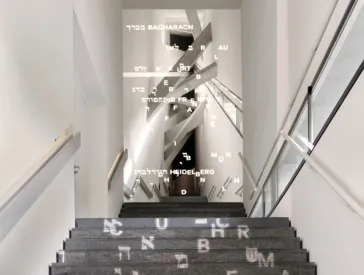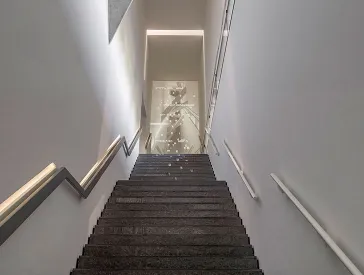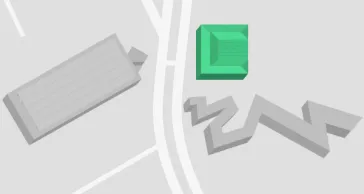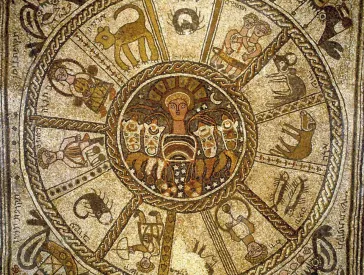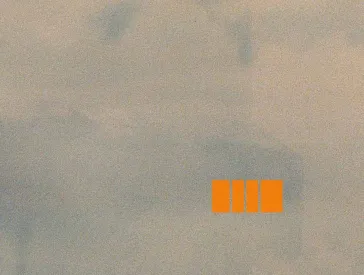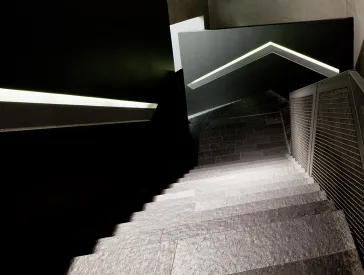A Time for Everything
Rituals Against Forgetting
This exhibition focused on strategies against forgetting from a Jewish perspective, on Jewish rituals of transition and remembrance. It showed the origin of these rituals, how they are practiced, and what they mean.
In addition to the cyclical religious rituals of remembrance, it presented strategies against historical forgetting.
Trailer for the exhibition
Rituals of Transition
Birth, childhood, school, coming of age, independence, marriage, old age, and death mark painful or joyful transitions between various phases of anyone’s life. Like other cultures, Judaism has developed specific strategies to ease the way through these transitions or help people grapple with them.
Jewish Holidays
The Jewish community also performs rituals recalling seminal events in Jewish history. These include annually recurring festivals such as Passover, which commemorates the Israelites’ exodus from Egypt; Hanukkah, the Festival of Lights, which commemorates the Maccabees’ victory; and Sukkot, the Feast of Booths, which commemorates the years of wandering through desert. All three festivals last a full week and recall important passages in Jewish history or turning points in the seasonal cycle.
The Curator Speaks About the Exhibition
Article Alles hat seine Zeit. Rituale gegen das Vergessen (en: A Time for Everything: Rituals Against Forgetting) by Felicitas Heimann-Jelinek in JMB Journal Nr. 9 (in German)
Download (PDF / 120.46 KB / in German / not accessible)The Objects
In the exhibition, some sixty objects from public and private collections represent these festivals as well as the universal nature of rites of passage, which many individuals experience uniquely.
We were delighted to present the debut of a special highlight: three writing slates that were excavated at the Archaeological Zone of the Jewish Museum of Cologne not long before the exhibition opening.
Cilly Kugelmann, program director of the Jewish Museum Berlin on the question: “What is special about this exhibition?”
Michael Wiehen (local excavation director, Archaeological Zone, Cologne) on three objects from the Middle Ages that were featured in the exhibit.
A Culture of Remembrance
Collective rituals can also be secular, some of these intended to establish and reinforce a national identity. Accordingly, contemporary commemorative rituals in Germany reflect the country’s own Nazi past and its crimes, the Shoah in particular.
The Special Block: Installations by Quintan Ana Wikswo
In this context, The American artist Quintan Ana Wikswo created a photographic investigation of the remains of the so-called Sonderbau (special block) in Dachau, used during the Nazi era as the concentration camp brothel. Wikswo employed original AGFA cameras that had been manufactured by women forced laborers in Dachau, manipulating the cameras before she used them. In her series Sonderbauten: The Special Block, shown in the exhibition, she juxtaposed these photographs against textual fragments. Wikswo’s pictures focus on undocumented and untold stories of Jewish suffering. Even today, this group of victims – women who were sexually exploited in concentration camps – is still omitted from public commemorative rituals.
A selection of these haunting, large-format photographs presents a challenging contrast to the comparatively “innocent” objects and rituals against forgetting shown nearby.
Shortened recording of the artist discussion with Quintan Ana Wikswo that took place in the exhibition rooms on 18 October, 2013.
Quintan Ana Wikswo
The artwork of Quintan Ana Wikswo is cross-disciplinary, located at the intersections of visual art, literature, film, and performance art. Her groundbreaking work has been shown in distinguished institutions and museums in New York, Los Angeles, France, and Germany. She lives in New York, where she is the co-artistic director of Fieldshift Further.
A Time for Everything: Rituals Against Forgetting was curated by Felicitas Heimann-Jelinek and designed by exhibition architect Martin Kohlbauer.
The exhibition was first created and shown at the Jewish Museum Munich from 27 February to 1 September 2013.
Exhibition Information at a Glance
- When 18 Oct 2013 to 9 Feb 2014
- Where Old Building, level 1
Lindenstraße 9-14, 10969 Berlin
See Location on Map
Extract from the Exhibition Catalogue
Object page concerning the theme “Remembering the Wandering”: Ushpizin chart
Download (PDF / 117.39 KB / in English and German)Extract from the Exhibition Catalogue
Quintan Ana Wikswo, SONDERBAUTEN: Der besondere Block/The Special Block
Download (PDF / 107.16 KB / in English and German)